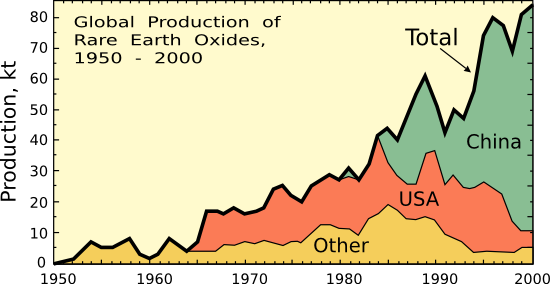Materials Supply Chain
July 14, 2014
As an accident of
natural selection,
humans have ten
fingers. This ten digit body plan is actually pervasive among
species, so the apparently
random choice of ten, and not eight or twelve, happened early in
evolution. Such similarities among species are called
homologies, and
Darwin cited these as evidence for a
common ancestor. It was easier for
nature to use the same simple structures, so these persisted with just small variation.

Bone structure of a whale fin, showing pentadactylity.
(Illustration by Volkov Vladislav Petrovich, via Wikimedia Commons.)
We have ten fingers, so our
arithmetic is
decimal. We tend to use whatever nature has given us. Our
civilization is likewise built from the
materials at hand. We use a lot of
wood, and we found many
millennia ago that scratching into
Earth's crust a little can give you
precious stones, and such useful
metals as
copper,
silver, and
gold. Later, we learned to extract
iron from
mined ores; and, much later, we learned how to make
synthetic diamonds.

Austrian iron miners in Minnesota, 1911.
Coal may have fueled the Industrial Revolution, but its principal material was iron.
I wrote about Thomas Edison's iron mining venture in a previous article (Edison's Iron Mine, September 20, 2010).
(Via Wikimedia Commons.)
Fortunately, the
Earth didn't
solidify into a
homogeneous mass. Because of
thermochemical forces, some
elements were concentrated into ores, and some
geographical regions have more of one kind of ore than another.
Rare earth elements, which are useful for making
catalysts,
photovoltaics and
permanent magnets, have been mined in the
United States,
India,
Brazil, and
South Africa, but
China is now the leading producer.
In a
previous article (Rare Earth Shortage, June 21, 2010), I described how China had started to
limit exports of these elements, and this policy has continued. China's limiting of rare earth
exports has encouraged the reopening of mining operations elsewhere, but there's still the problem of extraction. As are many other
chemical processes, extraction of rare earths from ore and their
purification are not that
environmentally friendly; but, how else can we get our
motorized automobile windows?

This graph illustrates how the US ceded its dominance in rare earth production to China in the mid-1980s. (Via Wikimedia Commons.)
The rare earth elements are not the only chemical elements that are part of the
high technology products we wouldn't want to live without. In a
previous article (Energy Elements, May 11, 2011), I wrote about a joint report of the The
American Physical Society (APS) and the
Materials Research Society (MRS), "Energy Critical Elements: Securing Materials For Emerging Technologies." [1-2] This report highlights the importance of many of the rare earth elements and other elements important to
energy technologies; viz.,
This report recommends product design for
recycling and
research and development on substitute materials. One mitigation technique cited in the report, but not likely to be popular, is
lifestyle adaptation. No automatic automobile windows for you!
The
US Department of Energy released a December, 2010, report on Critical Minerals Strategy.[3] This report highlights as "most critical" the rare earth elements, dysprosium, neodymium, terbium, europium and yttrium. Indium is also named as a most critical material. One interesting fact about indium, and a good reason for research on substitute materials, is that indium is a
byproduct of
zinc production. It's not likely that you would mine more zinc just to get more indium.
As if mineral scarcity wasn't enough, we now need to worry that our
technology contains extracts from
conflict minerals. These minerals are the technology equivalents of
blood diamonds that are used to fund
armed conflicts in
Africa.
Although "3TG" might sound like a new
cellphone service, this shorthand actually represents the four principal conflict minerals; namely, tantalum, tin, tungsten and gold. In the US, a
miscellaneous provision of the
Dodd–Frank Wall Street Reform and Consumer Protection Act of 2010 required
companies to disclose the sources of these materials in their products.
Rulemaking by the
US Securities and Exchange Commission, which was charged with the oversight for this law, wasn't completed until 2012. Since that time, US companies have attempted to track the mineral sources of their products. The first reports were due on May 31, 2014.
As can be imagined, this is a difficult task for many companies, since it applies not only to products that they make, but also to products that they have made for them by
contractors. In a May 29, 2014, filing,
Apple, Inc. reported that "...all tantalum
smelters in its supply chain had been designated 'conflict free'..."[4] As for the other metals, a majority were either certified as conflict free, or have been found to be so by an independent
auditors. Says Apple,
"Apple will keep up the pressure until all unaudited smelters and refiners are either certified or removed from Apple's supply chain."[4]
Intel announced early this year that all its
microprocessors would be free of conflict minerals.
In its own report,
Honeywell, Inc., a large
diversified manufacturer of such things as
jet engines and building
thermostats, wrote that it sells 915,000 products using materials from 24,000 direct material suppliers.[5] Honeywell does not deal with conflict mineral suppliers, directly, so it relies on reporting from its own suppliers. It has begun to require conflict mineral compliance into its new
purchase agreements.[5]

Honeywell model T87 round thermostat.
This extremely reliable device was based on the dissimilar thermal expansion of metals bonded together into a bimetallic strip and formed into a spiral shape. The electrical switch was a blob of mercury.
(Via Wikimedia Commons.)
![]()
References:
- Robert Jaffe, Jonathan Price, Murray Hitzman and Francis Slakey, "The Back Page - Energy Critical Elements," APS News, vol. 20, no. 4, March, 2010.
- Energy Critical Elements: Securing Materials for Emerging Technologies, A Report from the APS Panel on Public Affairs Committee and the Materials Research Society (MRS), February 2011.
- Critical Minerals Strategy (US Department of Energy, December, 2010).
- Conflict Minerals Disclosure for January 1 to December 31, 2013, Apple Inc., May 29, 2014.
- Conflict Minerals Report for the Year Ended December, 2013, Honeywell, Inc.
Permanent Link to this article
Linked Keywords: Natural selection; human; finger; species; randomness; random; evolution; homology; homologies; Charles Darwin; common descent; common ancestor; nature; Bone; whale; fin; Wikimedia Commons; arithmetic; decimal; civilization; material; wood; millennium; millennia; Earth's crust; gemstone; precious stone; metal; copper; silver; gold; iron; mining; mine; ore; synthetic diamond; Austria; Austrian; Minnesota; coal; fuel; Industrial Revolution; Thomas Edison; Earth; freezing; solidification; homogeneous mass; thermochemistry; thermochemical forces; chemical element; geography; geographical region; rare earth element; catalyst; photovoltaic; permanent magnet; United States; India; Brazil; South Africa; China; export; chemical reaction; chemical process; purification; environmentally friendly; electric motor; motorized; automobile; window; Cartesian coordinate system; graph; high tech; high technology; American Physical Society; Materials Research Society; energy technology; lanthanum; ruthenium; cobalt; cerium; rhodium; helium; praseodymium; palladium; lithium; neodymium; osmium; rhenium; samarium; iridium; silver; europium; platinum; gadolinium; terbium; dysprosium; gallium; ytterbium; germanium; lutetium; selenium; scandium; indium; yttrium; tellurium; recycling; research and development; lifestyle; United States Department of Energy; by-product; byproduct; zinc; technology; conflict resource; conflict mineral; blood diamond; armed conflict; Africa; mobile phone; cellphone; Dodd–Frank Wall Street Reform and Consumer Protection Act; company; rulemaking; U.S. Securities and Exchange Commission; independent contractor; Apple, Inc.; smelting; smelter; audit; auditor; Intel; microprocessor; Honeywell, Inc.; conglomerate; diversified manufacturer; gas turbine; jet engine; thermostat; purchase order; purchase agreement; thermal expansion; bimetallic strip; spiral; electrical switch; mercury.